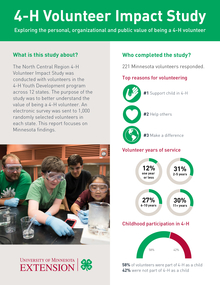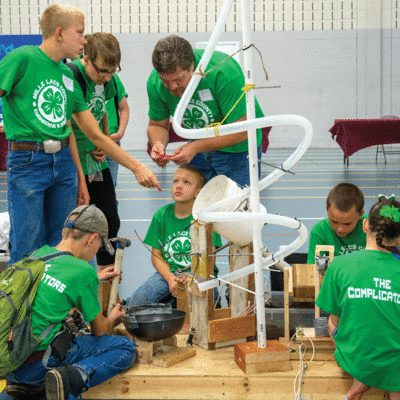Exploring the personal, organizational and public value of being a 4-H volunteer
What was this study about?
The north central region 4-H volunteer impact study was conducted with volunteers in the 4-H Youth Development program across 12 states. Minnesota 4-H and our partner states wanted to better understand the value of being a 4-H volunteer. We sent an electronic survey 1,000 randomly selected volunteers in each state. This report focuses on Minnesota findings.
Who completed the study?
221 Minnesota volunteers responded.
Top reasons to volunteer
#1: Support child in 4-H
#2: Help others
#3: Make a difference
Volunteer years of service
Childhood participation in 4-H
58% of volunteers were part of 4-H as a child. 42% were not.
How does the individual benefit?
Volunteers personally benefit from their 4-H involvement.
Volunteers come into the 4-H program hoping to support youth and make a difference. In the process, they gain skills in teaching, leadership and communication. These skills transfer to other environments in which volunteers work and live.
92% built new relationships with youth
“It was hard to speak in front of a group. I would talk fast and my sentences would veer from the main point. I find after volunteering in 4-H, I have relaxed and become a better leader.” —Volunteer, Goodhue County
86% gained skills that are useful in other settings
“My volunteer experience gave me confidence to apply for a management position at work and the experience to thrive in that position once I got it.” —Volunteer, Beltrami County
79% increased their confidence as a leader
“One important skill I have learned and used for other volunteering is how to not do it all myself. That was a hard one for me. Teaching and delegating responsibilities to others makes for stronger unity.” —Volunteer, Wadena County
How does our organization benefit?
4-H Youth Development benefits from volunteers.
Volunteers give their time, talents and energy to the 4-H program. On average, volunteers give nine hours per month, an annual contribution worth $2,600*. In addition to time, 90% of volunteers contributed supplies and 79% of volunteers contributed financially.
Volunteers serve as primary ambassadors for 4-H. They tell others about the importance of youth development, recruit new youth and volunteers and expand community partnerships.
Most importantly, youth benefit from volunteers. Volunteers help youth to learn new things, build confidence and to become leaders.
82% spoke about the value of the 4-H program with others
“4-H volunteers collaborate with other community members to work on community projects like cleaning up the park, planting flowers, helping elderly members of the community work on projects.”—Volunteer, Lac qui Parle County
78% made new connections in the community on behalf of 4-H
“My best 4-H experience is anytime I see a smile on a 4-H’er when they are proud of their accomplishments. It could be shooting a personal best, talking to a judge about what they learned when their project was not perfect, or when their dog finally sits for the designated time.” —Volunteer, Anoka County
73% recruited new youth to 4-H
“4-H puts kids in situations where they interact with other kids and adults of all ages. This really helps them develop skills for interacting with people who are different from themselves. When these children go out into the community they have the skills to get involved in school, sports, community activities etc. They become community leaders because of 4-H.” —Volunteer, Dakota County
61% recruited new volunteers
“4-H clubs, and adult volunteers, often come from various backgrounds that wouldn’t normally intersect at school, church or neighborhood. The more various groups can work together and get to know one another, the more connected a community will be.”—Volunteer, Washington County
69% taught other volunteers
How does the community benefit?
Communities are stronger because of 4-H Youth Development volunteers.
Volunteers have a positive impact where they live and work. They make communities stronger, connect communities to each other, improve community health and increase overall civic involvement. The value of 4-H volunteers extends far beyond the scope of youth development into every part of their community.
“Youth and adults work together toward common goals. We focus on strengths instead of weaknesses and strive to break down social barriers so that all feel welcome.”
—Volunteer, Norman County
“Local volunteers are willing to serve as civic leaders and usually have a good idea of what works for the community from youth to adult.”
—Volunteer, Murray County
Volunteers matter and they make a significant impact.
The 4-H program would not be possible without volunteers. Through their service, volunteers grow personally. They enrich the 4-H program and youth. They make our communities stronger.
You are welcome. Call 612-624-2116 to join us.
Reviewed in 2019










